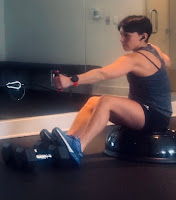Benefits of transcending all metabolic systems
Have you tried to run immediately after a tough weight lifting session? Or, have you tried to lift heavy after a long run? It's pretty tough when you do it for the first time, whether you are a runner or a weight lifter or just a fitness pal. There is more to it than just being a difficult workout and there is a reason why weight lifters do not enjoy "cardio" workouts or why runners do not enjoy spending much time in the weight room. This is because our muscles utilize different metabolic systems to produce energy during an activity depending on the duration and the intensity of the activity. Jumping from one system to another is not a smooth transition.
During a workout, our muscles utilize a various avenues to seek energy and do the job we are asking them to do. Depending on how hard or how long we ask them to perform, they tap into the following three energy paths: ATP-phosphocreatine (ATP-PC), glycolysis and aerobic metabolism or a combination of those. Typically, for a high-intensity exercise lasting less than 10 seconds, ATP-PC and glycolysis are recruited. However, for a 400m dash that lasts around 55sec, our muscles engage a combination of ATP-PC, glycolysis and aerobic systems. Anything longer than that and the aerobic system starts to kick in and taking over after 2 to 3min. We talked before about exercise duration and anaerobic/aerobic systems (The physiology and human performance across sports), which really stem from the muscle metabolic processes.
Anaerobic / Glycolytic system: The process of creating energy from either blood glucose or stored glycogen (in liver and muscles) that does not require oxygen (anaerobic). It can create 2 ATP energy molecules per 1 glucose molecule
Ex: a 10k run, a 5k walk or a low-level manual work 8hr shift
[Note: during a marathon run, an athlete may face total glycogen depletion and feel forced to slow down as the pace dictated cannot be fueled by carbohydrate storages anymore and fat oxidation needs to take over]
The type of metabolic system(s) recruited for a particular task is dictated by the duration and intensity of the task as well as the athlete's efficiency especially for the long aerobic efforts.
Events lasting approximately 60sec utilize 70%/30% anaerobic/aerobic systems for energy production [i.e., a combination of ATP-PC (required for just the first 1-5sec) followed by glycolysis and aerobic metabolism]. Events lasting 2 to 3 minutes utilize 50%/50% anaerobic/aerobic systems for energy production. When efforts extend beyond those minutes, the aerobic energy avenue starts to dominate the metabolic system. It is clear now that short bouts of weight lifting routine (that typically last a few seconds) require ATP-PC and glycolysis systems whereas a fast run (that lasts more than 10min) primarily requires the aerobic system. In sum:
Anaerobic / ATP-PC system: Immediate energy that does not require oxygen (anaerobic). It can create only 1 ATP energy molecule per 1 glucose molecule.
 |
| Percentage of energy derived from the four major sources of fuel during sub-max exercise |
Ex: a 5-10sec sprint, lifting heavy for 3-5reps or a baseball pitch
Anaerobic / Glycolytic system: The process of creating energy from either blood glucose or stored glycogen (in liver and muscles) that does not require oxygen (anaerobic). It can create 2 ATP energy molecules per 1 glucose molecule
Ex: a 200m-400m dash, an all-out 1.5min kettle bell explosive workout
Aerobic metabolism / Oxidative system: The process of continuing the glucose oxidation initiated by the glycolytic system. It involves three systems: Krebs cycle - Electron transport chain - Beta oxidation. It can create energy at a low rate by utilizing triglyceride and carbohydrate metabolisms (lipolysis - glycolysis) and it has nearly unlimited supply (from adipose sites). It typically creates 24-28 ATP energy molecules per 1 glucose molecule.
[Note: during a marathon run, an athlete may face total glycogen depletion and feel forced to slow down as the pace dictated cannot be fueled by carbohydrate storages anymore and fat oxidation needs to take over]
The type of metabolic system(s) recruited for a particular task is dictated by the duration and intensity of the task as well as the athlete's efficiency especially for the long aerobic efforts.
Training and specializing in events that rely more one system than another is paramount for increasing performance. However, performance is also enhanced by improving the athlete as a whole and making them more efficient in every metabolic system. For activities that require short bouts as well as long sustained high heart rate efforts, such a 1000m, 5000m or a marathon kayak/running race, the ability of an athlete to jump efficiently from one system to the other is important. Alternating weight lifting workouts with short high-interval or long sustained aerobic workouts allows the athlete to adapt and makes them stronger, more resilient and able to perform better.
Reference: "Exercise Physiology Theory and Application to Fitness and Performance"
by Soctt K. Powers and Edward T. Howley






Comments
Post a Comment